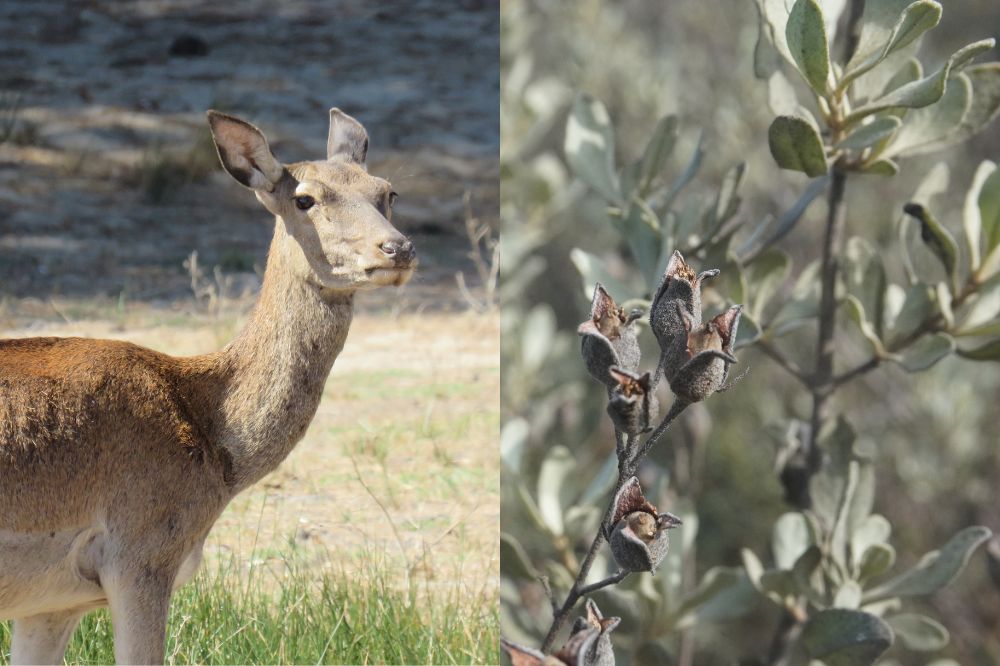The red deer is the main predator and long-distance seed disperser of one of Doñana’s most abundant shrubs

A study led by the Doñana Biological Station (EBD–CSIC) has revealed that the red deer (Cervus elaphus) simultaneously acts as both the main predator and long-distance seed disperser of the yellow rockrose (Cistus halimifolium), one of the most abundant shrubs in Doñana National Park. This is the first time that researchers have quantified the costs and benefits of the interaction between these two species to determine whether it is mutualistic (beneficial for both) or antagonistic. The study, published in Plant Biology, also involved scientists from Rey Juan Carlos University in Madrid.
A key interaction
Seed dispersal through animal ingestion (endozoochory) is generally considered a mutualistic relationship in which both partners benefit: the plant gains mobility and may improve its germination success, while the animal obtains nutrients and water. However, research on endozoochory has mostly focused on fleshy-fruited plants. Yet many animals—such as fish, birds, rodents, and ungulates—also consume dry fruits, as occurs with the yellow rockrose.
This shrub, belonging to the Cistaceae family, appears to lack a long-distance dispersal mechanism. “At the same time, the red deer is one of the most abundant ungulates in Doñana National Park, so the interaction between both species could be key to the yellow rockrose’s colonization of new habitats,” explains Rocío Fernández-Fuerte, a predoctoral researcher at the Doñana Biological Station (CSIC) and lead author of the study.
To evaluate the plant–ungulate relationship, the researcher installed nine camera traps in each of two study plots (Matasgordas and Reserva), which remained active for ten days. Complementary analyses included collecting and examining deer feces and conducting germination experiments with recovered seeds.
The photographs revealed that the red deer is the main consumer of yellow rockrose, accounting for 85.7% of all recorded visits to the plant. Fecal analyses showed a low occurrence of seeds (4.5%), while germination tests indicated significantly lower germination rates in seeds retrieved from deer droppings (17%) compared to control seeds collected directly from the plant (40%).

A dual role
Los The results demonstrate that the red deer plays a dual role as both predator and long-distance disperser of Cistus halimifolium. On one hand, heavy consumption of immature fruits and seeds, combined with their passage through the digestive tract, leads to their destruction—reducing effective dispersal and compromising the plant’s reproductive success. On the other hand, although few seeds survive digestion, those that do highlight an important mutualistic role for the deer as a long-distance seed disperser through endozoochory.
When this effect is extrapolated to the entire populations of both species in Doñana, deer-mediated dispersal could significantly contribute to the colonization and genetic connectivity of yellow rockrose populations across the National Park.
Future studies
Future studies on the spatial and temporal variation of this interaction will be crucial to understanding how factors such as plant phenology and ungulate density influence its ecological effects. In addition, more detailed research on the impact of gut passage on seed viability is essential.
“Understanding the interaction between two of Doñana’s most abundant species—and how it varies depending on ecological factors—may be key to establishing a gradient between mutualism and antagonism in plant–animal interactions that fluctuate within the ecosystem,” Fernández-Fuerte emphasizes.
Reference
Fernández‐Fuerte, R., Garrote, P. J., Virgós, E., & Fedriani, J. M. (2025). The dual role of red deer in yellow rockrose seed dispersal and predation in Mediterranean Spain. Plant Biology. Doi: https://doi.org/10.1111/plb.70102